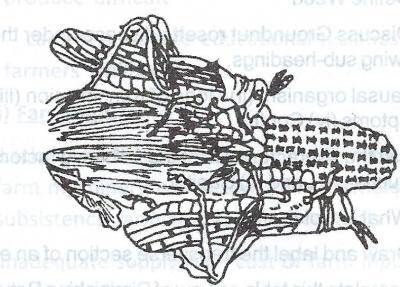The content is just an excerpt from the complete note for SS2 Second Term Biology Lesson Note – Pest and Diseases of Crops. Check below to download the complete DOCUMENT
WEEK 8
CLASS: SS2
TOPIC: PEST AND DISEASES OF CROPS
CONTENT:
- Life cycles of pests
- Control of pests
- Diseases caused by pest and their agents
(a) Fungal diseases
(b) Viral diseases
(c) Bacterial diseases
(IV) Control of pest.
DEFINITION OF PESTS
Pests are organisms that carry disease or cause damage to other organisms. Pests may be plants or animals. Plant pests are usually called weeds. Pests are very important to man because of their detrimental effects to humans and other organisms of concern to man e.g. agriculture or livestock production.
Crop pests are those that affect agricultural produce important to man, e.g. insects, birds etc. Livestock pests attack livestock useful to man e.g. Mites, Lice, Tapeworms.
Pests usually decrease the quantity and quality of agricultural production, especially when present in large numbers.
Crop-Destroying Weevils
Weevils are among the most destructive of pests that attack agricultural crops. Adult weevils lay their eggs in stalks or seeds of crops such as cotton, wheat, rice, and alfalfa. As larvae, weevils then feed on these plant tissues, extensively damaging the plant in the process.
EVALUATION
- What are pests?
- What make pest so important to man?
- Mention 3 common pests you know.
SUB-TOPIC 1: CLASSIFICATION OF PESTS
Classification based on the various parts of a crop plant they attack:
- Stem borers: these are usually larvae of certain moths that bore into the stems of maize and feed on it. This result in the weakening and breaking of the stem.
- Root feeders: these are insect larvae or adults found in the soil. They burrow into the ground and feed on yam tubers.
- Leaf feeders: snails, bettles, grasshoppers eat up leaves of crops.
- Young shoot feeders: aphids, mealy bugs and scale insects usually pierce and suck out juices from young shoots. Many sucking pests also transmit disease-causing organisms to the plants e.g. Cassava leaf mosaic virus is transmitted by white flies. Such pests are known as vectors.
- Fruits and seed feeders: these are moths, fruit flies, cotton strainers and some beetles eat their way into fruits and seeds causing great damage.
Damaged Crops in North Korea
A North Korean farmer assesses the damage done to his corn crop by poor growing conditions. In the mid-1990s severe flooding followed by droughts devastated the country’s agricultural output and led to serious food shortages. By the late 1990s North Korea was experiencing widespread famine.
Other invertebrate and vertebrate pests include:
- Insects like flies, aphids
- Mites and ticks.
- Snails
- Flatworms
- Tapeworms
- Protozoa
- Birds
- Rodents
To gain full access to the note: DOWNLOAD FILE



